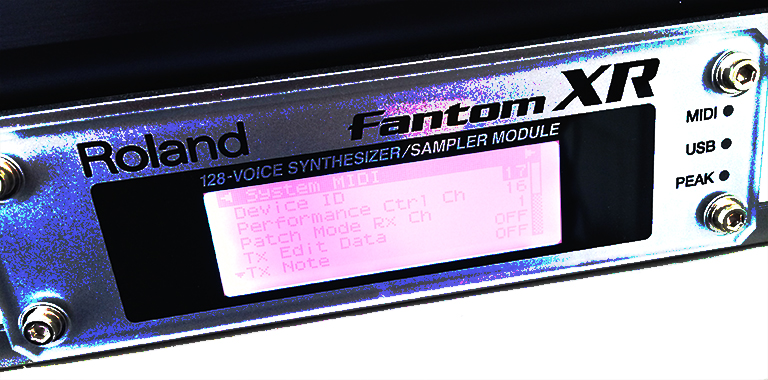Roland Fantom XR
Ironic Mission Number 1.
To succinctly, successfully and in sentences sequestered from supercilious syllable spawning, survey a selection of screenshots specific to a synthesiser’s sophisticated software…
You know me well, my aversion to manuals and proclivity to press, pause, pray, panic, , procrastinate, push again. Why is there no STILL no sound? I had it made. Two days ago when I went through this precise process, it worked, I had a signal, there was Reverb when I clicked and dragged that wretched rotary. Last Sunday, when I switched to output B, there were stupendous sonics, now there is sombre silence and I swear NOTHING has shifted. Enter dear mother with another cup of Lap Sang…

“Are you certain it’s not a lose connection?” she good naturedly enquires…
“All the cables are XLRs” I bark back with unwarranted brusqueness. “The most robust type there is, three pins and a locking jack and slavishly soldered by Julian, our imperious sparky. Lose connections are as likely as a winning lottery ticket inside a cowrie shell on a bed of four leaf clovers. “Ether that or a left wing communist.”
“I think you mean Right Wing,” she responds, casually retreating.
“No, actually”. says I, delighted at the opportunity to appear literately lucid in the midst of a reckless routing rampage.
“I did mean left wing, I was being sarcastic, I thought you were an Orwellian…don’t you remember Animal Farm? The animals looked from man to pig and then….
“You were bring ironic, not sarcastic,” she shouted from the kitchen, not missing a beat. “What’s an XLR anyway?”
With clenched teeth I decide to quit while behind by a little under a country mile and refocus on relative fortes. The source of the hysteria this time around were the legions of knob, switch and slider rich GUIs enabling exorbitant governance over our Fantom’s fathomless vocal verve and serpentine signal flow, no doubt self-explanatory to numerous notating nerds with academic acumen and a slice of common sense.
Enough at least to open their XR’s dumb founding dossier at page one, skip to page 101, not in ignorant haste but owing to their lack of fluency in a succession of Chinese dialects, before proceeding to instinctively ingest and clinically commit to memory every instruction likely to quell their operational quandaries, including all those nested in Roland’s signature post script “NOTES” and “TIPS”.
Regrettably, I am not blessed with such qualities as methodical frontal lobe management or the patience to position my cart behind its horse. Solace for me comes from random familiarization. Not really knowing what you want to achieve before you’ve been allowed to wander liberally around your tone teeming toy as you did the site or store from whence it came. Not instantly understanding how a “creative investment” can assist your ambitions hither to marvelling at its functional merits, and fortuitously experiencing their potential with exploratory points and impulsive clicks.
As much as anything, negotiating the complexities of the studio’s incoming recruits is an exercise in self-assurance, to convince my troubled conscience that should times turn really tough in a dodeca dip recession. If rationing were to once again be widespread in a plague of poverty and manuals no longer accompanied state-of-the-art musical aids, I’d still be able to configure them with serene confidence.
Technical obstacles, repeated attempts at recourse, as many mistakes as possible, belated but rewarding remedies and finally, a frantically scribed, disjointed account of my discoveries for desperate future reference by minds too artistically attuned to suffer the agonies of “manual labour”. That, my friends, is a fitting summary of what awaits your divided and voluntary perusal.
“Oh, just read it!” yells my maternal adviser, half way up the oaken stairs. “It was probably written by someone exactly like you…with humility enough to learn from others”.
A MIDI THRU Prelude.
If the option “USB-MIDI Thru” is set to “ON”, when the unit receives a MIDI signal either directly through its MIDI input or via that of another USB device connected to the same computer, such as an additional synthesiser or MIDI I/O adapter, the Integra’s MIDI 1 output will behave exactly like a conventional MIDI THRU port and re-broadcast these signals to any device that is connected to it.
However, this will only be possible when an application that fully utilizes the Integra’s USB driver and that of the other device – if applicable – is running. Prime examples would be sequencing software such as Sonar, Cubase and Logic.
The function will also enable the MIDI OUTPUT to relay data that originates from internal transmissions, such as those generated when a MIDI recording is played back in a one of the aforementioned programs on tracks to which the Fantom’s instruments have been allocated, or that occur when a MIDI file is opened up in utilities like QuickTime or Media player and the Fantom has been specified as the OS’s default MIDI device.
When this feature is enabled, the unit will be able to play back tones and simultaneously forward the data to its midi output but will remain silent in standalone mode when receiving signals from an external controller.
By contrast, the MIDI THRU port will never forward internal playback signals, but will always duplicate those received by the Fantom’s MIDI input to a connected device, regardless of whether or not USB MIDI thru is active.




